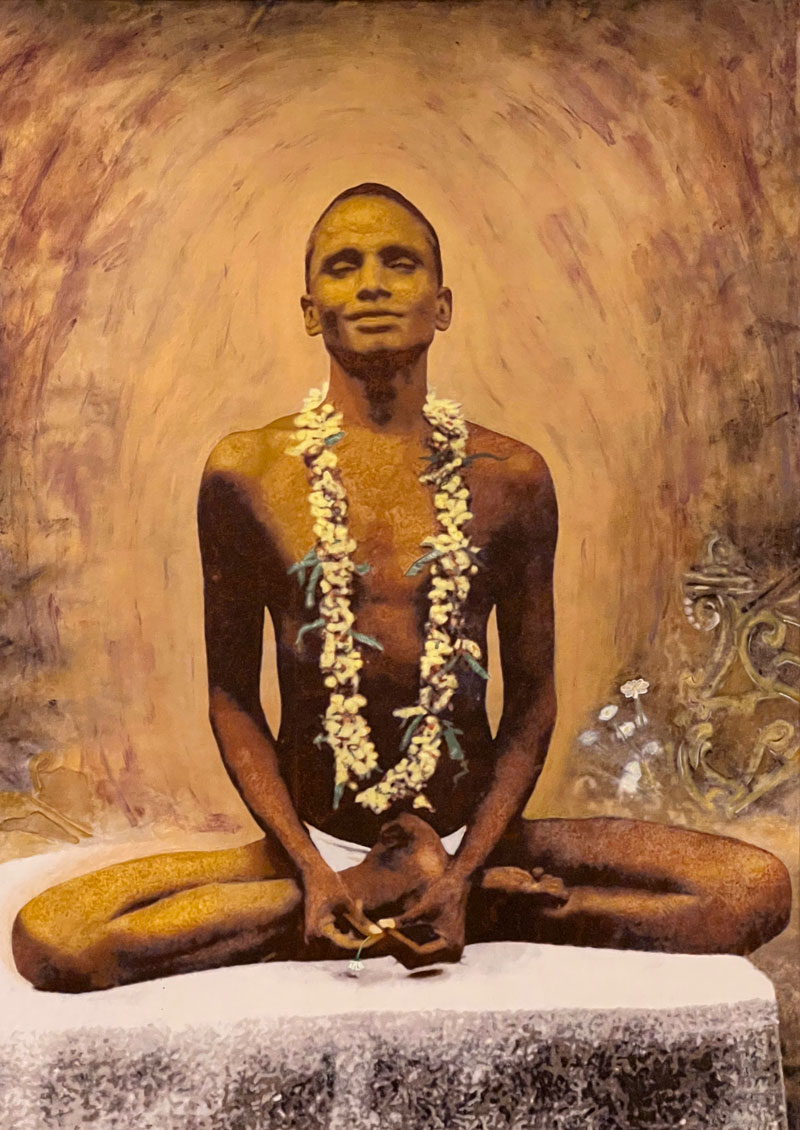Yogic Understanding
UNION WITH SELF
Expanded consciousness or intelligence takes the form of awareness which is pure and connected to Self. Contracted consciousness identifies with the restless thinking mind, the past and the information that comes through the senses.
My teacher illustrated this clearly using the following Siva Sutra –
Caitanyam Atma sutra 1.1
Caitanyam is pure consciousness which allows the light of Self to come through
Atma is Self, which is defined by the following characteristics:
absolute freedom, in other words, nobody can control it
jnana or knowledge there is an all-knowing point within
kriya or action in other words, Atma can do what needs to be done
it is Self-luminous like the sun
Caitanyam Atma – Pure consciousness is the nature of Atma
Another way of describing pure consciousness is through the following three qualities:
ready to know it’s ready and willing to learn
know it already understands
make known it can pass the understanding on effectively
Yoga unites you with your wholeness. The ego tricks you into separating from wholeness. As a human being on planet Earth, no one escapes the difficulty of this dilemma, everyone is in this same situation.
At times, we have all heard a voice within say ‘I knew I shouldn’t have done that’. This inner voice is your intuition, which is a ray from Self. The most practical means of connecting with Self is by learning how to always breathe a complete breath which then allows you to feel. Like a blind persons walking stick, breathing and feeling enters the ever-changing present moment and connects the outer world with the inner world. The beauty of connecting to this space in yourself is it is neutral and without pressure. No judgement of right or wrong, failure or success, it is only interested in being aware and learning. The role of this awareness is simply to watch things as they are and report back.
THE FOUR MAIN STYLES OF YOGA
Each of the four main styles of yoga is helpful and useful in different ways. Like using a knife, fork, spoon and plate you would be missing out on just using one of these as they are each more appropriate at certain times.

KARMA YOGA
Developing the ability to do things for the love of doing them without wanting anything back in return.
This is a very important and practical yoga that once learnt well can be applied to any situation. Expectation brings unrealistic pressure onto situations. Ironically the best results come when you try your best and let go of the rest. Karma Yoga is an opportunity to practice a more effective approach to the things you do by letting go of other motives and purely enjoying the task. It traditionally involves hands-on work that allows space to connect with the activity. Practiced over time, Karma Yoga brings a person closer to the foundation of yoga which is service and love. Both of these aspects ensure yoga continues to be passed on.
‘I remember my first Karma Yoga task was at a yoga retreat. My role was to stand at the front of the driveway entrance greeting and directing people as they arrived. Just after sunset, the majority of people had arrived and I began to feel a bit left out standing outside while everyone chatted inside over a cup of tea. Essentially this habit of desiring things to be other than the way they are was stopping me from enjoying performing my role.’
Through practice you learn that making sure your role is covered allows you to be covered. Like learning to be a good team player, Karma Yoga connects you to what is happening through playing your part in it. A lot of the really valuable changes for me occurred working in cafes on minimum wages, scrubbing dishes and serving customers for fourteen years – simply by learning to enjoy doing whatever needed to be done.

RAJ YOGA
The process of being guided by eight steps to purify behaviour, body, breath and mind.
Raj Yoga is also called the Eight Limbs of Yoga which is later discussed in more detail in Patanjali’s Yoga Sutras (hyperlink). As the eight steps progress they lead you to subtler and more powerful levels of yourself with each limb enhancing and supporting the others.
If your behaviour is creating problems, you will always have to come back to fix this in order to have peace and harmony in the body and mind. The first and second limbs of Raj Yoga – the Yamas and Niyamas – provide a framework to do just this.
The third limb, Asana or Posture, is ultimately a training ground to understand and focus your mind, while at the same time improving your posture. Every little change you make in this direction will give you more freedom and growth from the day before. ‘A mistake I made many times here was trying to collect postures and always wanting to be able to do more advanced postures. With time under my teacher’s guidance, I saw that this approach weakens areas and takes you away from feeling content.’
The fourth limb, Pranayama, is learning how to regulate the breath to work optimally for you. The more you learn to always breathe a deeper balanced breath the more balanced your life becomes. This is a very simple principle that you can rely on and has an instantaneous effect.
To simplify the fifth, sixth, seventh and eighth limbs, you could say that their focus shifts more to your inner world. As the understanding of your inner world develops it becomes easier to be centred and feel comfortable. Meditation is your natural state when everything is balanced and harmonious within, it can also be described as learning to merge with the focus of your mind.
‘It was after 12 years that I could feel meditation throughout a busy lunchtime shift at the cafe. Funnily enough, the key to this was simply learning to playfully let go. Letting go of what I was doing without forgetting it, so I could help do something else when required.’

BHAKTI YOGA
The yoga of opening the heart.
Bhakti Yoga is the cream on the cake! The main technique used in this yoga is chanting, similar to singing when you’re happy. Really everyone wants to feel loved and chanting allows you to directly experience this. It is one of the easiest ways to stop thinking and just be emerged in feeling from the heart whilst in good company. The essence and meaning of all yoga chants is to guide you closer to the energy and intelligence within. If you can relax when chanting and gently sway, this helps to openly try it before judging it.
‘I wasn’t a very musically inclined person growing up, however, my entry into chanting was made a little easier as I related to the feeling of letting go and enjoying music while at dance parties.’
Chanting goes straight to the point of feeling within. Sound vibration moves from the navel, up through the heart, throat and into the skull which has the tremendous benefit of releasing blockages in these areas.
“Chanting goes where no medicine can reach” Swami Muktananda
There are many different types of chanting which are all valuable to use and beneficial in different ways. Yogic chants are sung in Sanskrit, an ancient language which literally means “polished”. It has an elevated vibration with a great range of sound variation and expression. The power of these sacred Sanskrit chants grows the more they are sung and appreciated.

JNANA YOGA
The yoga of understanding one’s own mind, not identifying with its thoughts and remaining in a state of I AM awareness.
Jnana Yoga is difficult to practice independently as there isn’t the occupying of the mind by techniques to help it stay focused. It is simply the state of remaining neutral in the position of the observer or witness. Integrating Jnana Yoga with the other three main styles of yoga helps to ground this awareness into day-to-day life.
‘I used to place pressure on myself during difficult situations by thinking something was wrong. I remember the feeling well when that pressure was removed simply by accepting that these things were happening to me for a reason, perfectly, as they needed to in order for me to learn more about what was causing them.’
Really that is what each moment is – an opportunity to learn.
Each time you exercise your ability to let go of thinking about external things and just come back to awareness of breath or observing stillness, you are building your relationship with Jnana Yoga. Seeing that there is always a deeper part of you to return to, behind your changing thoughts. Just like when you leave your house but remain aware of how to get back home. This naturally happens as the breath starts to spread into the back and crown of the head.
To be in a state of I AM awareness doesn’t mean you are spaced out, it is the opposite. You are aware of the outside world, aware of your inner world and you know the difference between the two. We are all made up of millions of cells joined together, functioning through energy and intelligence. The more you appreciate and acknowledge this truth, the more you know I AM THAT.
SAT-CHIT-ANANDA
The joy of uniting with the truth or the joy of understanding the truth.
Satchitananda is a Sanskrit word close to the heart of yoga. Made up of three words to describe the nature of ultimate reality where things are unified.
Sat being the truth or that which doesn’t change
Chit being consciousness or the intelligence that understands this truth
Ananda being the feeling of bliss or joy when the energy wells up within and flows freely
Generally, if a situation in life has occurred where a person feels like they are butting heads, it is because the truth of the situation hasn’t been understood or is being resisted. Through yoga, you learn how to sincerely enquire into what is really happening and view the situation with a slightly different perspective. There are few skills more valuable than that of finding and uniting with the truth.
‘It took me quite a while to always allow for the fact that my teacher was seeing something that I didn’t. Because he had put far more time and energy into learning under a realistic framework of yoga it was only natural that this be the case. Acknowledging this point allowed me to drop this approach. From here onwards, I instead went to feeling grateful when he could see something I couldn’t.’
BHAGAVAD GITA
The Bhagavad Gita is one of India’s most valued teachings that uses an ancient story to explain life and apply yoga to life’s actions.
The story is set right before a battle. In the centre of the battlefield is a great warrior named Arjuna and beside him is his enlightened teacher. The conch shells are blowing as the battle is about to occur. Arjuna at this point looks around to either side and begins to recognise the faces of family and friends on either side. He becomes disheartened and loses his will to fight, turning to his teacher he asks for guidance.
His enlightened mentor then explains:
“That by which all this universe is pervaded by is indeed indestructible, the seed of which is energy and consciousness. These bodies are inhabited by this energy and consciousness, the indestructible embodied Self. For the born there is certain death, for the dead there is certain birth, don’t be deluded about this inevitable consequence.”
Arjuna, interested to learn, then asks his teacher how to achieve this understanding.
The reply follows:
“Yoga is skill in action! Not performing action for its fruits, nor inaction. Instead offer up your actions as service, renouncing any attachment to the fruits. Sacrifice, giving and austerity are purifiers moving you closer to perfection.”
Over and over Arjuna asks his teacher for another truth and again and again his teacher offers him yet another perspective:
“Perceiving your warrior duty, do not tremble, indeed anything superior to righteous battle does not exist for a man of warrior caste. If victorious, enjoy the victory, if you are slayed performing honourably the Self evolves accordingly as in nature. For a warrior, to not act is to live in shame. Either way, the battle will go ahead and people will be slain.”
Now not afraid, Arjuna understands with a rekindled flame.
This story teaches us how to move through life and deal with challenges in an expanded and free way. Playing your role in life without unnecessary pressure from the doubting mind trying to control what it cannot.
Patanjali is often referred to as the grandfather of yoga and is believed to have lived between 500 – 200 B.C. He wrote the Yoga Sutras in Sanskrit which consist of 196 short statements, arranged into four sections, that concisely describe yoga.
E-book soon coming ♥
Uniting With Your Wholeness
Yoga unites you with your wholeness. The ego tricks you into separating from wholeness. As a human being on planet Earth, no one escapes the difficulty of this dilemma, everyone is in this same situation.
Valley Hub
Yoga of Self
since 2018
Om Cafe & Convenience Store
since 2019
Currumbin Valley Harvest
since 2020
“Om Currumbin Valley, how you make us happy”
Follow Us
Please DM us on Instagram for more information
Yoga Of Self Studio
“Expanded consciousness or intelligence takes the form of awareness which is pure and connected to Self.”
© 2023 Yoga of Self | Web: YOUNET

